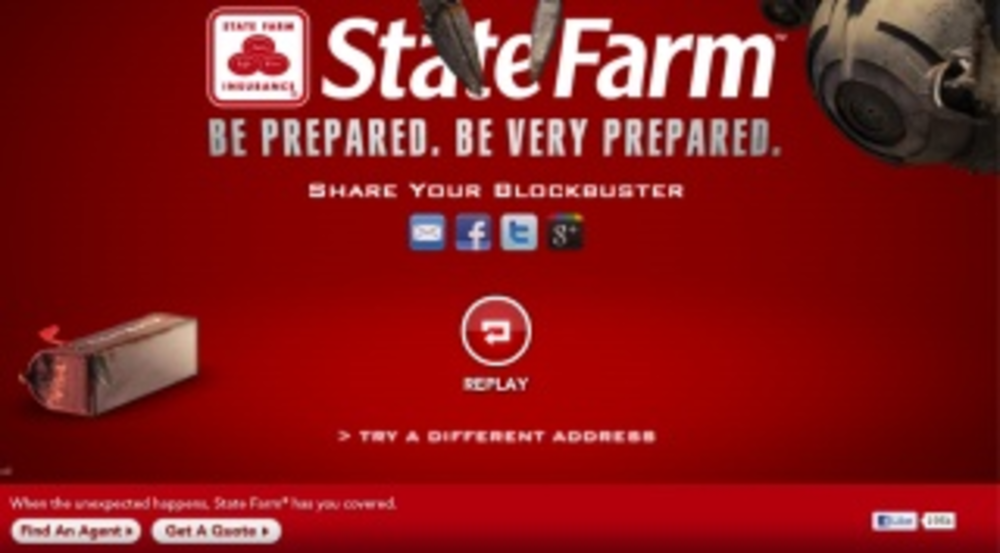Healthcare reform and signs of economic recovery have insurance marketers retooling their direct marketing efforts to drive relevant messaging to consumers and prospects. Marketers are putting a premium on offering personalized, accurate content to different consumer demographics, while balancing privacy concerns.
While many marketers have had to trim their budgets in recent years, the insurance industry has witnessed steady spending growth over the past few years. During the first three quarters of 2011, insurance television advertising spending increased 10% and Internet advertising spending increased 40% compared to the same period in 2010, according to Kantar Media.
Much of this spending has gone into campaigns that personalize the abstruse world of insurance. Beginning in June, State Farm‘s “Get To A Better State” campaign has emphasized the company’s local agents through targeted marketing. The “State of Chaos” television ad features a giant robot wreaking havoc on a neighborhood. The ad is complemented by a microsite that invites visitors to disclose their home address in order to see the robot attack their house through Google Street View. After watching the video, viewers are then offered the opportunity to request a quote or find the nearest agent.
“We need to really understand who it is we want to reach out to, and then look at the factors of, ‘What do they think today?’ ‘What do we want them to think about or know about us after the communication?’” says Tim Van Hoof, manager of marketing and communications at State Farm.
Consumer cultural differences have shaped State Farm’s company marketing as it seeks out pockets of potential business and opportunities where consumers may be wholly unaware of insurance products that may be of value to them, Van Hoof says.
Targeting is all in the timing
Hiscox USA found that when it sent its direct mail was almost as important as the recipient.
John Lee, VP of insurance and wealth management at Merkle, which works with insurance clients including GEICO, says CRM investments are key to determining the right approach. “It was one thing when the agent down the street was doing all that vetting, and it was really about building the brand from the marketing perspective, but now it’s much more about that microsegmentation and targeting,” he says. “Fortune 100 companies with $10, or $20, or $50 billion in premiums are making sophisticated CRM investments for the first time.”
This is particularly true in the area of employer benefits. Changes to healthcare law have led to a growing interest in worksite insurance, in which the employee covers more of the cost for their benefits and has more choice in what kind of coverage they receive.
“We’re positioning ourselves for a future where voluntary coverage is the dominant form,” says Gene Lanzoni, assistant VP of market intelligence at Guardian Life. “We have to be really good consumer marketers.”
Guardian Life recently rolled out the program, Enrollment Works, which offers educational information and news, and an application to allow visitors to calculate how much they would be paying for their health benefits to determine if they need the various add-ons and plans.
“The combination of digital, mobile applications and Web content helps us make positive inroads,” says Robert Guay, SVP of marketing at Digitas, which handles marketing for Aflac. “Direct offers an opportunity to explain the true benefit of insurance to people and our particular brand of insurance in ways we can’t get done in 30 seconds of television or in a display ad.”
Guay describes direct as one tier of Aflac’s marketing efforts, approached alongside higher-level brand affinity efforts.
“In our organization, we focus not just on the response rate, but also on the long-term view — will this prospect develop into a loyal customer or not?” says Neeraj Arora, assistant VP of customer experience at Farmers Insurance Group.
Farmers uses SAS software to analyze customer lifetime profitability by tracking demographic and psychographic data. Since applying this approach and incentivizing agents based on the findings, the company has witnessed a 14% increase in its internal rate of return.
Insurance marketers are also able to tailor their messaging by partnering with third parties. American National Insurance Company does most of its business with financial institutions like Wells Fargo and Bank of America, as well as smaller regional banks and credit unions.
On the direct mail side, which is 80% of the company’s business, American National trades on the relationship the customer has with the sponsoring brand. American National has credit cards, mortgage and checking account customers, and so the message varies slightly depending on what type of account holder they are targeting.
This kind of partnership requires a careful balance, tailoring communications not only for the account holder, but for the demands of the sponsoring organization.
“While we might be really aggressive in the broad market, we can’t be quite as aggressive with the bank customers as we’d like to be sometimes,” says Richard Katz, VP of direct marketing and sales at American National Insurance Company.








